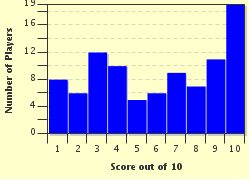Quiz Answer Key and Fun Facts
1. Which New England born, nineteenth century poet, and staunch abolitionist, wrote the poem, "Snow Bound"?
2. Which renowned literary critic, lecturer, essayist, and author, which early twentieth century poet wrote the poem, "The Donkey"?
3. Having won the Poetry Society's Award in 1918, and author of the poem, "I Shall Not Care", which female poet was further honored in 1994 when she was inducted into the St. Louis Walk of Fame?
4. A poet and well known author of children's stories, who wrote the alliterative poem "Silver"?
5. Due to a tubercular infection, and subsequent leg amputation, which English poet wrote the poem, "Invictus"?
6. Which reclusive, prolific, nineteenth century poet wrote the poem, "There is no Frigate like a Book"?
7. Which Irish poet and lyricist, originally from Ulster (Northern Ireland) wrote the poem, "The Old Woman" under Gaelic form of his name, Seosamh Mae Cathmhaoil?
8. Influenced by John Cardinal Newman, which Jesuit priest wrote the poem, "God's Grandeur"?
9. Which handsome English poet, who served his country in World War I, wrote the poem, "The Soldier"?
10. Who wrote the magical and mysterious poem, "The Fairies", which is frequently part of elementary school poetry studies?
Source: Author
Irishrosy
This quiz was reviewed by FunTrivia editor
bloomsby before going online.
Any errors found in FunTrivia content are routinely corrected through our feedback system.

